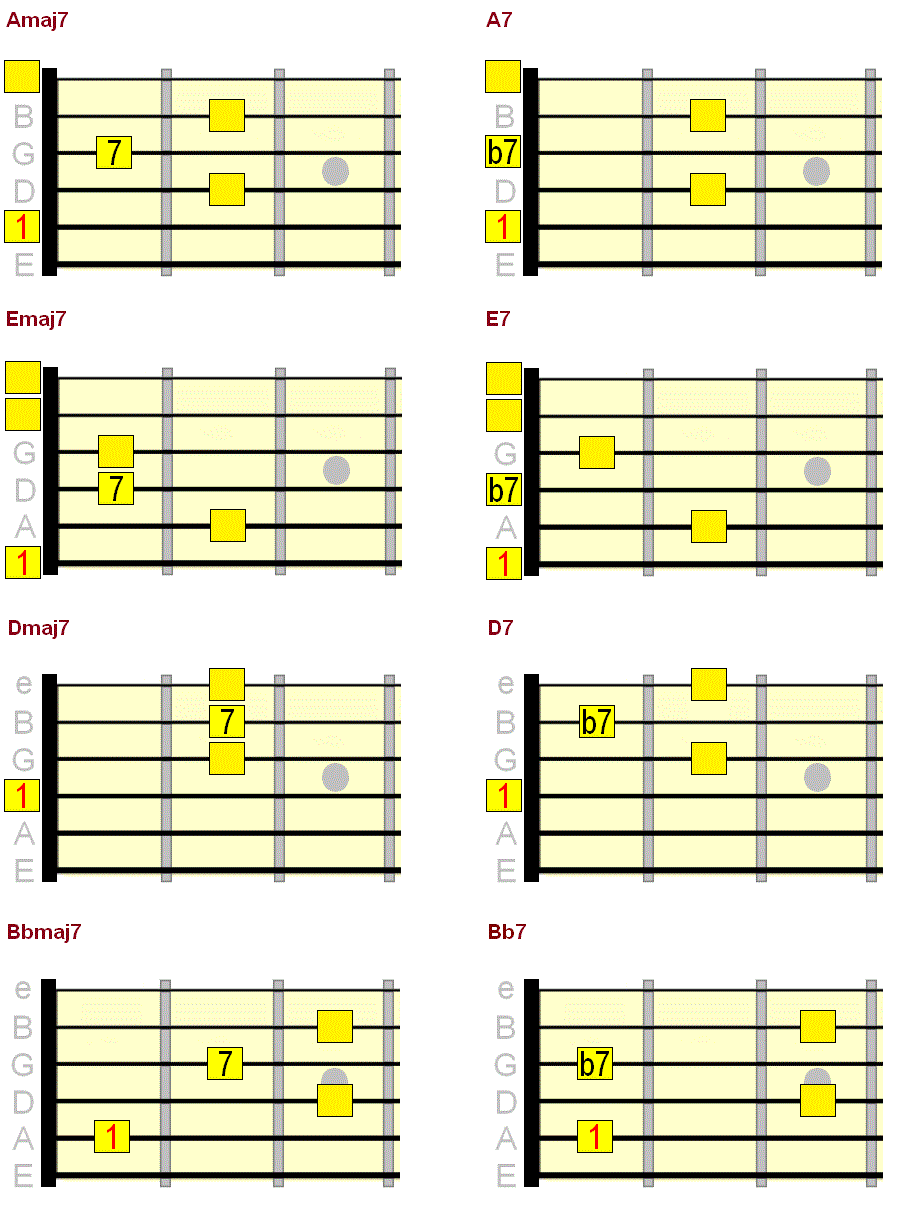Home
> Ear Training - 7th Chords
In the first part we learned how to recognise the difference between major and minor chords by ear. It made sense to begin there as major and minor chords make up the majority of songs.
But an extra note is often added to these major and minor chords - called a seventh - giving the chord a more complex quality.
Like before, I'll take you through some simple ear training exercises that will help you identify when the chord being played is a 7th chord. This skill won't just help you with transcribing music by ear. It'll also help you work out which notes/scales are best for soloing (we'll get to that!).
What's important is that you can pick out this 7th in the chord and identify which type of 7th chord it is. I know that sounds difficult, but the more you expose the auditory part of your brain to it, the more discerning you'll become.
There are four main types of seventh chord - major seventh, dominant seventh, minor seventh and minor major seventh.
They almost sound identical. How would you describe the quality of the second chord compared with the first? Dreamier? Prettier? More emotive? Those are my descriptions, but you'll no doubt have your own. This is about associating the sound of the chord with a descriptive response, an identifier in the brain.
Listen again, but this time I'm going to emphasise the major 7th of the chord...
Go back to that first clip again and try to pick out that major 7th in a similar way to how I emphasised it in the second clip. You can hum the 7th if you like to help.
In theoretical terms, the major seventh is always one semitone below the root of the chord. So in C major, the major 7th would be... B.
Take a listen to the C root and major 7th of B in isolation before bringing the rest of the chord in...
Below I start by emphasising the major 7th in Ebmaj7. I then play the chord as normal - try to keep your ear focused on that major 7th tone...
Again, I'll start by playing regular C major followed by C7 (C dominant 7th)...
Has a much more "bluesy" feel than the major 7th to my ears. Less relaxed. More unstable.
Again, I'll emphasise that minor 7th interval in the chord...
Whereas a major 7th was only a semitone down from the root, a minor 7th is one whole tone down from the root. So in C7, the 7th would be... Bb (B flat).
This time let's hear Ebdom7, but I'm going to isolate the root and minor 7th before bringing in the rest of the chord...
7 = major 7th b7 = minor 7th

Can you hear how the 7th moves down one semitone from the maj7 to b7? That's the only difference between the two chords. The more you can internalise this difference, the better.
Finally, we need to test our ability to distinguish between the two types of 7th chord, and regular major chords, in different consecutive positions. In the following clips, each one playing three chords, try to identify whether each chord played is a basic major chord, major 7th or dominant 7th. Answers in the small print below each clip...
Answer: 1st chord = dom7, 2nd chord = dom7, 3rd chord = major
Answer: 1st chord = dom7, 2nd chord = maj7, 3rd chord = dom7
Answer: 1st chord = major, 2nd chord = maj7, 3rd chord = dom7
Answer: 1st chord = maj7, 2nd chord = dom7, 3rd chord = maj7
For more ear training, use Fachords' chord recognition game. See how far you can get.
Next stop, the two remaining 7th chords - minor 7th and minor major 7th.
Share your thoughts...
Have any questions, thoughts or ideas about this lesson? Let us know using the comments form below.
7th Chords Ear Training the Simple Way
In the first part we learned how to recognise the difference between major and minor chords by ear. It made sense to begin there as major and minor chords make up the majority of songs.
But an extra note is often added to these major and minor chords - called a seventh - giving the chord a more complex quality.
Like before, I'll take you through some simple ear training exercises that will help you identify when the chord being played is a 7th chord. This skill won't just help you with transcribing music by ear. It'll also help you work out which notes/scales are best for soloing (we'll get to that!).
Why 7th?
The name 7th refers to a particular interval (note, essentially) added to the basic major or minor chord. If you haven't studied intervals yet, don't worry as this lesson is more about recognising the different 7th chord qualities by ear. You could theoretically call them whatever you want!What's important is that you can pick out this 7th in the chord and identify which type of 7th chord it is. I know that sounds difficult, but the more you expose the auditory part of your brain to it, the more discerning you'll become.
There are four main types of seventh chord - major seventh, dominant seventh, minor seventh and minor major seventh.
Major 7th Chord Ear Training
Major 7th chords are major chords with an added major 7th interval (so 1 3 5 7). You'll hear them used in music all the time. Rather than me explain what they are in theoretical terms, start by taking a listen to this clip of a normal C major chord followed by a Cmaj7 (C major 7th) chord...They almost sound identical. How would you describe the quality of the second chord compared with the first? Dreamier? Prettier? More emotive? Those are my descriptions, but you'll no doubt have your own. This is about associating the sound of the chord with a descriptive response, an identifier in the brain.
Listen again, but this time I'm going to emphasise the major 7th of the chord...
Go back to that first clip again and try to pick out that major 7th in a similar way to how I emphasised it in the second clip. You can hum the 7th if you like to help.
In theoretical terms, the major seventh is always one semitone below the root of the chord. So in C major, the major 7th would be... B.
Take a listen to the C root and major 7th of B in isolation before bringing the rest of the chord in...
Below I start by emphasising the major 7th in Ebmaj7. I then play the chord as normal - try to keep your ear focused on that major 7th tone...
Dominant 7th Chord Ear Training
Another commonly used variation on the major chord. Dominant 7th chords add a minor 7th to major chords (so 1 3 5 b7). I know that's kind of confusing, but again let's focus on what they sound like!Again, I'll start by playing regular C major followed by C7 (C dominant 7th)...
Has a much more "bluesy" feel than the major 7th to my ears. Less relaxed. More unstable.
Again, I'll emphasise that minor 7th interval in the chord...
Whereas a major 7th was only a semitone down from the root, a minor 7th is one whole tone down from the root. So in C7, the 7th would be... Bb (B flat).
This time let's hear Ebdom7, but I'm going to isolate the root and minor 7th before bringing in the rest of the chord...
7th Intervals in Chord Shapes
Like in the previous lesson, you can develop your ability to hear these 7th intervals by playing some simple 7th chord shapes and isolating the 7th. You'll probably already know some (or all) of these...7 = major 7th b7 = minor 7th

Distinguishing Major 7th and Dominant 7th Chords by Ear
To further internalise the distinction between maj7 and dom7, we can listen to the two chords played consecutively on the same root. Try and follow the movement of the 7th when the chord change happens. We're moving from maj7 to dom7...Can you hear how the 7th moves down one semitone from the maj7 to b7? That's the only difference between the two chords. The more you can internalise this difference, the better.
Finally, we need to test our ability to distinguish between the two types of 7th chord, and regular major chords, in different consecutive positions. In the following clips, each one playing three chords, try to identify whether each chord played is a basic major chord, major 7th or dominant 7th. Answers in the small print below each clip...
Answer: 1st chord = dom7, 2nd chord = dom7, 3rd chord = major
Answer: 1st chord = dom7, 2nd chord = maj7, 3rd chord = dom7
Answer: 1st chord = major, 2nd chord = maj7, 3rd chord = dom7
Answer: 1st chord = maj7, 2nd chord = dom7, 3rd chord = maj7
For more ear training, use Fachords' chord recognition game. See how far you can get.
Next stop, the two remaining 7th chords - minor 7th and minor major 7th.
| Was this
helpful? Please support this site. I really appreciate it! |
Stay updated
and learn more Sign up to the newsletter for updates and grab your free Uncommon Chords book |
Share your thoughts...
Have any questions, thoughts or ideas about this lesson? Let us know using the comments form below.
Part 3 Coming Soon!
< More Guitar Playing Advice








